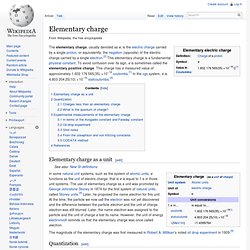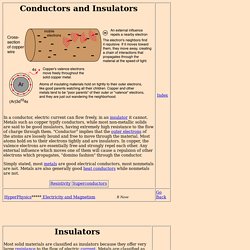

Elementary charge. Elementary charge as a unit[edit] In some natural unit systems, such as the system of atomic units, e functions as the unit of electric charge, that is e is equal to 1 e in those unit systems.

The use of elementary charge as a unit was promoted by George Johnstone Stoney in 1874 for the first system of natural units, called Stoney units.[4] Later, he proposed the name electron for this unit. Www.sweethaven02.com/Science/PhysicsCalc/Ch0201.pdf. Conductors and Insulators. In a conductor, electric current can flow freely, in an insulator it cannot.

Metals such as copper typify conductors, while most non-metallic solids are said to be good insulators, having extremely high resistance to the flow of charge through them. "Conductor" implies that the outer electrons of the atoms are loosely bound and free to move through the material. Most atoms hold on to their electrons tightly and are insulators. In copper, the valence electrons are essentially free and strongly repel each other. Charges and Fields 2.04. Electromagnetic induction. Electromagnetic induction is the production of a potential difference (voltage) across a conductor when it is exposed to a varying magnetic field.

It is described mathematically by Faraday's law of induction, named after Michael Faraday who is generally credited with the discovery of induction in 1831. History[edit] A diagram of Faraday's iron ring apparatus.